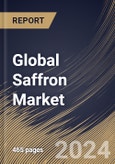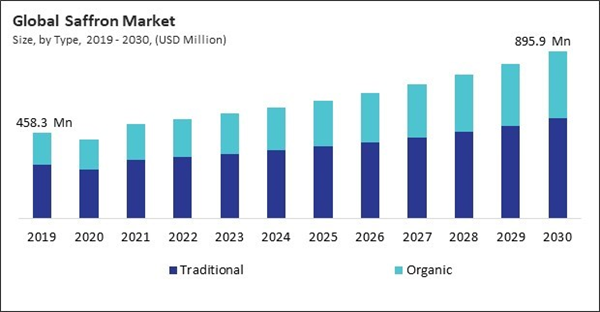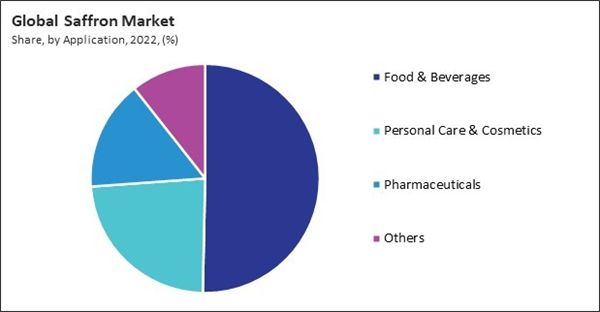The Global Saffron Market size is expected to reach $895.9 million by 2030, rising at a market growth of 6.9% CAGR during the forecast period. In the year 2022, the market attained a volume of 844.5 tonnes, experiencing a growth of 6.3% (2019-2022).
Liquid saffron provides a convenient and ready-to-use form, making it easy for consumers to integrate saffron into their culinary creations. Consequently, the liquid segment would generate an approximately 18.28 % share of the market by 2030. The liquid format eliminates the need for manual processing of saffron threads, offering a time-saving solution for home cooks and professional chefs. Therefore, these factors can fuel the demand in the segment.
Saffron contains compounds with antioxidant properties, such as crocin and safranin. Antioxidants help neutralize free radicals in the body, which may contribute to aging and various chronic diseases. The perceived health benefits of saffron as an antioxidant-rich spice have attracted health-conscious consumers. Therefore, owing to these factors, there will be enhanced demand for saffron.
Additionally, Saffron imparts a unique, rich flavor and a distinctive golden color to dishes. Its aromatic qualities contribute to enhancing the overall sensory experience of a dish. Chefs appreciate saffron’s ability to add complexity and depth to various recipes. Therefore, the market will expand rapidly in the upcoming years.
However, Harvesting saffron involves carefully plucking these delicate threads by hand. This process is labor-intensive and time-consuming, requiring precision to avoid damaging the saffron threads. The need for skilled laborers and the manual nature of the harvesting contribute significantly to production costs. Hence, these aspects can hamper the growth of the market.
Liquid saffron provides a convenient and ready-to-use form, making it easy for consumers to integrate saffron into their culinary creations. Consequently, the liquid segment would generate an approximately 18.28 % share of the market by 2030. The liquid format eliminates the need for manual processing of saffron threads, offering a time-saving solution for home cooks and professional chefs. Therefore, these factors can fuel the demand in the segment.
Saffron contains compounds with antioxidant properties, such as crocin and safranin. Antioxidants help neutralize free radicals in the body, which may contribute to aging and various chronic diseases. The perceived health benefits of saffron as an antioxidant-rich spice have attracted health-conscious consumers. Therefore, owing to these factors, there will be enhanced demand for saffron.
Additionally, Saffron imparts a unique, rich flavor and a distinctive golden color to dishes. Its aromatic qualities contribute to enhancing the overall sensory experience of a dish. Chefs appreciate saffron’s ability to add complexity and depth to various recipes. Therefore, the market will expand rapidly in the upcoming years.
However, Harvesting saffron involves carefully plucking these delicate threads by hand. This process is labor-intensive and time-consuming, requiring precision to avoid damaging the saffron threads. The need for skilled laborers and the manual nature of the harvesting contribute significantly to production costs. Hence, these aspects can hamper the growth of the market.
By Type Analysis
On the basis of type, the market is divided into organic and traditional. The traditional segment recorded the 61.5 % revenue share in the saffron in 2022. Traditional saffron is often perceived as more authentic and purer, resonating with consumers who prioritize these qualities. The emphasis on traditional cultivation methods and processing techniques contributes to the distinct flavor profile and aromatic characteristics that consumers associate with genuine, high-quality saffron. Therefore, the segment will grow rapidly in the upcoming years.By Distribution Channel Analysis
By Distribution Channel the market is segmented into B2B and B2C. In 2022, the B2C segment garnered a 40.93 % revenue share in the market. The rise of home cooking, particularly during lockdowns and increased focus on homemade meals, has contributed to the surge in demand in the B2C segment. Consumers seeking premium ingredients for their home-cooked dishes are turning to saffron to enhance their culinary creations’ flavor and visual appeal. Hence, these aspects will assist in the growth of the segment.By Application Analysis
On the basis of application, the market is divided into pharmaceuticals, personal care & cosmetics, food & beverages, and others. The food and beverages segment recorded the 50.3 % revenue share in the market in 2022. Saffron is increasingly sought after as a premium ingredient in the food industry. Its unique and intense flavor profile, coupled with the vibrant color it imparts to dishes, positions saffron as a valuable addition to premium food offerings, catering to consumers seeking elevated culinary experiences. Therefore, these factors will fuel the demand in the segment.By Form Analysis
Based on form, the market is divided into liquid, powder, stigma, petals, and stamen. The powder segment procured a 23.27 % revenue share in the market in 2022. Saffron powder is favored for its ease of incorporation into various dishes. Home cooks and chefs find saffron powder convenient, as it eliminates the need for manual grinding or steeping, allowing for quick and effortless integration into recipes. This uniform dispersion enhances the overall taste and aroma of dishes, providing a consistent saffron experience in every bite. Thus, these factors can assist in the expansion of the segment.By Grade Type Analysis
Based on grade type, the market is segmented into grade I, grade II, grade III, and grade IV. The grade I segment held the 41.23% revenue share in the market in 2022. There is a discernible trend among consumers towards prioritizing premium and high-quality food products. Grade I saffron, noted for its exceptional quality, brilliant color, and rich flavor profile, has become a popular choice among those seeking a more refined culinary experience. Therefore, owing to these factors, the segment will witness increased demand in the coming years.By Regional Analysis
By region, the market is segmented into North America, Europe, Asia Pacific, and LAMEA. In 2022, the North America segment acquired a 10.69 % revenue share in the market. The demand for saffron in North America is propelled by the region's culinary diversity and a growing interest in exploring unique and premium ingredients. Consumers, chefs, and home cooks alike incorporate saffron into various dishes, adding a touch of sophistication and exotic flavors to their culinary creations. Thus, the segment will expand rapidly in the coming years.List of Key Companies Profiled
- Esfedan Saffron Co.
- Safrante Speciality Foods S.A
- Tarvand Saffron Ghayen Company
- Azafranes Manchegos S.L
- Gohar Saffron Co.
- Rowhani Saffron Co.
- Mehr Saffron
- Dorren Saffron
- Royal Saffron Company
- Triselecta, S.A
Market Report Segmentation
By Type (Volume, Tonnes, USD Million, 2019-2030)- Traditional
- Organic
- B2B
- B2C
- Food & Beverages
- Personal Care & Cosmetics
- Pharmaceuticals
- Others
- Petals
- Powder
- Liquid
- Stigma
- Stamen
- Grade I
- Grade II
- Grade III
- Grade IV
- North America
- US
- Canada
- Mexico
- Rest of North America
- Europe
- Germany
- UK
- France
- Russia
- Spain
- Italy
- Rest of Europe
- Asia Pacific
- China
- Japan
- India
- South Korea
- Singapore
- Malaysia
- Rest of Asia Pacific
- LAMEA
- Brazil
- Argentina
- UAE
- Saudi Arabia
- South Africa
- Nigeria
- Rest of LAMEA
Table of Contents
Chapter 1. Market Scope & Methodology
Chapter 2. Market at a Glance
Chapter 3. Market Overview
Chapter 4. Global Saffron Market by Type
Chapter 5. Global Saffron Market by Distribution Channel
Chapter 6. Global Saffron Market by Application
Chapter 7. Global Saffron Market by Form
Chapter 8. Global Saffron Market by Grade Type
Chapter 9. Global Saffron Market by Region
Chapter 10. Company Profiles
Companies Mentioned
- Esfedan Saffron Co.
- Safrante Speciality Foods S.A
- Tarvand Saffron Ghayen Company
- Azafranes Manchegos S.L
- Gohar Saffron Co.
- Rowhani Saffron Co.
- Mehr Saffron
- Dorren Saffron
- Royal Saffron Company
- Triselecta, S.A
Methodology

LOADING...










